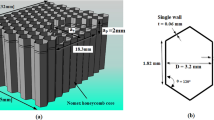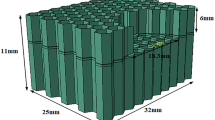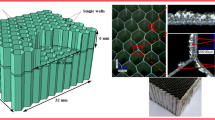Abstract
The manufacture of aluminum honeycomb structures is a major concern for companies in the aerospace industry, due to its out-of-plane high strength and stiffness-to-weight ratio. However, the shaping of this type of structure represents a technical challenge for engineers and researchers in terms of premature wear of the cutting tool and the quality of the machined surface. Generally, machining studies are based on experimental tests. Nevertheless, the experimental procedure fails to follow the mechanism of chip formation due to high rotational speeds of the cutting tool. To this end, it is necessary to use robust and reliable numerical models to access instantaneous and much localized physical quantities. For this purpose, we have developed a 3D finite element model associated with real working conditions using the Abaqus/Explicit analysis software. Based on this model, an experimental validation was carried out by analyzing the appropriate behavior laws. Furthermore, the influence of the geometry of the cutting tool in terms of the number of teeth on the size of the chips, the cutting forces, and the quality of the generated surface was analyzed. The obtained results show that the integrity of the cutting tool can be optimized and the quality of the machined surface can be improved.














Similar content being viewed by others
Availability of data and materials
Not applicable.
Code availability
Not applicable.
References
Wadee MA (2000) Effects of periodic and localized imperfections on struts on nonlinear foundations and compression sandwich panels. Int J Solids Struct 37(8):1191–1209. https://doi.org/10.1016/S0020-7683(98)00280-7
Caserta GD, Iannucci L, Galvanetto U (2011) Shock absorption performance of a motorbike helmet with honeycomb reinforced liner. Compos Struct 93(11):2748–2759. https://doi.org/10.1016/j.compstruct.2011.05.029
Qiu K, Ming W, Shen L, An Q, Chen M (2017) Study on the cutting force in machining of aluminum honeycomb core material. Compos Struct 164:58–67. https://doi.org/10.1016/j.compstruct.2016.12.060
(2020) Machining an aluminum honeycomb by ice fixation. Chin J Mech Eng 33(1): 1-8. https://doi.org/10.1186/s10033-020-00439-1
Zarrouk T, Salhi JE, Atlati S, Nouari M, Salhi M, Salhi N (2022) Modeling and numerical simulation of the chip formation process when machining Nomex. Environ Sci Pollut Res 29(1):98–105. https://doi.org/10.1007/s11356-021-13736-6
Zarrouk T, Nouari M, Salhi JE, Makich H, Salhi M, Atlati S, Salhi N (2022) Optimization of the milling process for aluminum honeycomb structures. Int J Adv Manuf Technol 119(7):4733–4744. https://doi.org/10.1007/s00170-021-08495-0
Zarrouk T, Salhi JE, Nouari M, Salhi M, Chaabelasri E, Makich H, Salhi N (2022) Modeling machining of aluminum honeycomb structure. Int J Adv Manuf Technol 1–20. https://doi.org/10.1007/s00170-022-10350-9
Zarrouk T, Salhi JE, Nouari M, Salhi M, Atlati S, Salhi N, Makich H (2021) Analysis of friction and cutting parameters when milling honeycomb composite structures. Adv Mech Eng 13(7):16878140211034840. https://doi.org/10.1177/16878140211034841
Clifton RJ (2000) Response of materials under dynamic loading. Int J Solids Struct 37(1–2):105–113. https://doi.org/10.1016/S0020-7683(99)00082-7
Fernández-Abia AI, Barreiro J, López de Lacalle LN, Martínez-Pellitero S (2012) Behavior of austenitic stainless steels at high speed turning using specific force coefficients. Int J Adv Manuf Technol 62:505–515. https://doi.org/10.1007/s00170-011-3846-9
Johnson GR (1983) A constitutive model and data for materials subjected to large strains, high strain rates, and high temperatures. Proc. 7th Inf. Sympo. Ballistics p 541–547
Kolopp A, Alvarado RA, Rivallant S, Bouvet C (2013) Modeling impact on aluminium sandwich including velocity effects in honeycomb core. J Sandwich Struct Mater 15(6):733–757. https://doi.org/10.1177/1099636213501102
Kolopp A. Impact sur structures sandwiches pour application de blindage aéronautique. (Doctoral dissertation 2012, Toulouse 3)
Tsaknopoulos K, Walde C, Tsaknopoulos D, Champagne V, Cote D (2020) Characterization of thermally treated gas-atomized Al 5056 powder. Materials 13(18):4051. https://doi.org/10.3390/ma13184051
Makich H, Nouari M, Jaafar M (2022) Surface integrity quantification in machining of aluminum honeycomb structure. Procedia CIRP 108:693–697. https://doi.org/10.1016/j.procir.2022.03.107
Dolatabadi F. Étude de l’influence du mode de lubrification sur les performances d'usinage du composite à matrices d’aluminium (Doctoral dissertation 2010, École Polytechnique de Montréal)
Xie G, Yu X, Gao Z, Xue W, Zheng L (2022) The modified Johnson-Cook strain-stress constitutive 1model according to the deformation behaviors of a Ni-W-Co-C alloy. J Market Res 20:1020–1027. https://doi.org/10.1016/j.jmrt.2022.07.053
Liu X, Ma H, Fan F (2021) Modified Johnson-Cook model of SWRH82B steel under different manufacturing and cold-drawing conditions. J Construct Steel Res 186:106894. https://doi.org/10.1016/j.jcsr.2021.106894
Johnson GR, Cook WH (1985) Fracture characteristics of three metals subjected to various strains, strain rates, temperatures and pressures. Eng Fract Mech 21(1):31–48. https://doi.org/10.1016/0013-7944(85)90052-9
Kang P, Youn SK, Lim J (2013) Modification of the critical projectile diameter of honeycomb sandwich panel considering the channeling effect in hypervelocity impact. Aerosp Sci Technol 29(1):413–425. https://doi.org/10.1016/j.ast.2013.04.011
Tie B, Tian BY, Aubry D (2016) Theoretical and numerical modeling of membrane and bending elastic wave propagation in honeycomb thin layers and sandwiches. J Sound Vib 382:100–121. https://doi.org/10.1016/j.jsv.2016.06.027
Burlayenko VN, Sadowski T (2010) Effective elastic properties of foam-filled honeycomb cores of sandwich panels. Compos Struct 92:2890–2900. https://doi.org/10.1016/j.compstruct.2010.04.015
Grediac M (1993) A finite element study of the transverse shear in honeycomb cores. Int J Solids Struct 30:1777–1788. https://doi.org/10.1016/0020-7683(93)90233-W
Akbar F, Mativenga PT, Sheikh MA (2010) An experimental and coupled thermo-mechanical finite element study of heat partition effects in machining. Int J Adv Manuf Technol 46:491–507. https://doi.org/10.1007/s00170-009-2117-5
Wang X, Shi J (2013) Validation of Johnson-Cook plasticity and damage model using impact experiment. Int J Impact Eng 60:67–75. https://doi.org/10.1016/j.ijimpeng.2013.04.010
Yameogo D, Haddag B, Makich H, Nouari M (2019) A physical behavior model including dynamic recrystallization and damage mechanisms for cutting process simulation of the titanium alloy Ti-6Al-4V. Int J Adv Manuf Technol 100:333–347. https://doi.org/10.1007/s00170-018-2663-9
Akbari M, Buhl S, Leinenbach C, Wegener K (2016) A new value for Johnson Cook damage limit criterion in machining with large negative rake angle as basis for understanding of grinding. J Mater Process Technol 234:58–71. https://doi.org/10.1016/j.jmatprotec.2016.03.009
Alberdi A, Artaza T, Suárez A, Rivero A, Girot F (2016) An experimental study on abrasive waterjet cutting of CFRP/Ti6Al4V stacks for drilling operations. Int J Adv Manuf Technol 86:691–704. https://doi.org/10.1007/s00170-015-8192-x
Kruszka L, Janiszewski J (2015) Experimental analysis and constitutive modelling of steel of A-IIIN strength class. In EPJ Web Conf 94:05007. https://doi.org/10.1051/epjconf/20159405007
Jaafar M, Étude expérimentale et simulation numérique de l’usinage des matériaux en nids d’abeilles: application au fraisage des structures Nomex® et Aluminium (Doctoral dissertation 2018, Université de Lorraine)
Author information
Authors and Affiliations
Contributions
TZ performed analyzed and interpreted data and results. JES was a major contributor in writing the manuscript. MN analyzed and interpreted data and was a major contributor in writing the manuscript. MS analyzed and interpreted data and results. JK was a major contributor in writing the manuscript.
Corresponding author
Ethics declarations
Ethics approval
Not applicable.
Consent to participate
Not applicable.
Consent for publication
Not applicable.
Competing interests
The authors declare no competing interests.
Additional information
Publisher's note
Springer Nature remains neutral with regard to jurisdictional claims in published maps and institutional affiliations.
Rights and permissions
Springer Nature or its licensor (e.g. a society or other partner) holds exclusive rights to this article under a publishing agreement with the author(s) or other rightsholder(s); author self-archiving of the accepted manuscript version of this article is solely governed by the terms of such publishing agreement and applicable law.
About this article
Cite this article
Zarrouk, T., Salhi, JE., Nouari, M. et al. Influence of the cutting tool geometry on milling aluminum honeycomb structures. Int J Adv Manuf Technol 126, 313–324 (2023). https://doi.org/10.1007/s00170-023-11144-3
Received:
Accepted:
Published:
Issue Date:
DOI: https://doi.org/10.1007/s00170-023-11144-3




